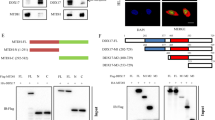Abstract
Dysregulation of Hippo-Yes-associate protein (YAP) signaling has important roles in the tumorigenesis of hepatocellular carcinoma (HCC). Our previous studies have shown that Cip1 interacting zinc finger protein 1 (CIZ1) activated YAP signaling in the HCC cells and promoted the growth and migration of cancer cells. However, the mechanisms for the activation of YAP signaling by CIZ1 are unknown. In this study, it was found that CIZ1 interacted with the transcriptional factor YAP in HCC cells. The nuclear matrix anchor domain of CIZ1 is responsible for its interaction with YAP. Moreover, CIZ1 enhanced the interaction between YAP and TEAD. Knocking down the expression of CIZ1 impaired the transcriptional activity as well as the biological functions of YAP. Taken together, our study demonstrated that CIZ1 is a positive regulator of YAP signaling, and CIZ1 might be a therapeutic target for HCC.




Similar content being viewed by others
References
Yu FX, Zhao B, Guan KL. Hippo pathway in organ size control, tissue homeostasis, and cancer. Cell. 2015;163(4):811–28.
Badouel C, McNeill H. SnapShot: the Hippo signaling pathway. Cell. 2011;145(3):484–484 e1.
Zhao B, Guan KL. Hippo pathway key to ploidy checkpoint. Cell. 2014;158(4):695–6.
Zhang W et al. VGLL4 functions as a new tumor suppressor in lung cancer by negatively regulating the YAP-TEAD transcriptional complex. Cell Res. 2014;24(3):331–43.
Zhang K et al. YAP and TAZ take center stage in cancer. Biochemistry. 2015;54(43):6555–66.
Avril T, Chevet E. Proteostasis trumps YAP in colon cancer. Sci Signal. 2015;8(397):fs18.
Yang S et al. Active YAP promotes pancreatic cancer cell motility, invasion and tumorigenesis in a mitotic phosphorylation-dependent manner through LPAR3. Oncotarget. 2015;6(34):36019–31.
Zhao B, Lei Q, Guan KL. Mst out and HCC in. Cancer Cell. 2009;16(5):363–4.
Jie L et al. The Hippo-yes association protein pathway in liver cancer. Gastroenterol Res Pract. 2013;2013:187070.
Wang C et al. Knockdown of yes-associated protein inhibits proliferation and downregulates large tumor suppressor 1 expression in MHCC97H human hepatocellular carcinoma cells. Mol Med Rep. 2015;11(6):4101–8.
Perra A et al. YAP activation is an early event and a potential therapeutic target in liver cancer development. J Hepatol. 2014;61(5):1088–96.
Han SX et al. Expression and clinical significance of YAP, TAZ, and AREG in hepatocellular carcinoma. J Immunol Res. 2014;2014:261365.
Li H et al. Yes-associated protein expression is a predictive marker for recurrence of hepatocellular carcinoma after liver transplantation. Dig Surg. 2014;31(6):468–78.
Liu AM, Poon RT, Luk JM. MicroRNA-375 targets Hippo-signaling effector YAP in liver cancer and inhibits tumor properties. Biochem Biophys Res Commun. 2010;394(3):623–7.
Wang Y et al. MiR-506 suppresses proliferation of hepatoma cells through targeting YAP mRNA 3'UTR. Acta Pharmacol Sin. 2014;35(9):1207–14.
Higashi T et al. miR-9-3p plays a tumour-suppressor role by targeting TAZ (WWTR1) in hepatocellular carcinoma cells. Br J Cancer. 2015;113(2):252–8.
Li X et al. Co-activation of PIK3CA and Yap promotes development of hepatocellular and cholangiocellular tumors in mouse and human liver. Oncotarget. 2015;6(12):10102–15.
Li L et al. MEK1 promotes YAP and their interaction is critical for tumorigenesis in liver cancer. FEBS Lett. 2013;587(24):3921–7.
Xu MZ et al. AXL receptor kinase is a mediator of YAP-dependent oncogenic functions in hepatocellular carcinoma. Oncogene. 2011;30(10):1229–40.
Copeland NA et al. Cyclin-A-CDK2-mediated phosphorylation of CIZ1 blocks replisome formation and initiation of mammalian DNA replication. J Cell Sci. 2015;128(8):1518–27.
Zhang D et al. CIZ1 promoted the growth and migration of gallbladder cancer cells. Tumour Biol. 2015;36(4):2583–91.
Warder DE, Keherly MJ. Ciz1, Cip1 interacting zinc finger protein 1 binds the consensus DNA sequence ARYSR(0–2)YYAC. J Biomed Sci. 2003;10(4):406–17.
Higgins G et al. Variant Ciz1 is a circulating biomarker for early-stage lung cancer. Proc Natl Acad Sci U S A. 2012;109(45):E3128–35.
Takigawa Y, Brown AM. Wnt signaling in liver cancer. Curr Drug Targets. 2008;9(11):1013–24.
Acknowledgments
This work was supported by International Science and Technology Cooperation Program of the Ministry of Science and Technology (2011DFA32980), One Hundred Person Project of the Shanghai Health (XBR2013117), and the National Natural Science Foundation of China (NSFC81271694).
Author information
Authors and Affiliations
Corresponding authors
Ethics declarations
Conflicts of interest
None
Rights and permissions
About this article
Cite this article
Lei, L., Wu, J., Gu, D. et al. CIZ1 interacts with YAP and activates its transcriptional activity in hepatocellular carcinoma cells. Tumor Biol. 37, 11073–11079 (2016). https://doi.org/10.1007/s13277-016-4866-8
Received:
Accepted:
Published:
Issue Date:
DOI: https://doi.org/10.1007/s13277-016-4866-8




